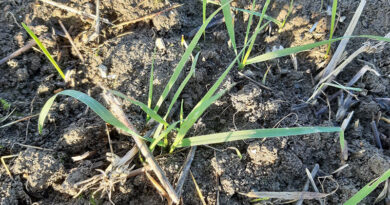Australia: Barley work at CCDM fights back at net blotch
21 February 2023, Australia: Researchers at the Centre for Crop and Disease Management (CCDM) have discovered good sources of resistance to pathogens causing net form net blotch (NFNB) and spot form net blotch (SFNB), allowing growers to expect improved variety resistance in the near future.
NFNB and SFNB disease outbreaks were widespread throughout the 2022 season in Western Australia’s barley growing regions. According to project leader of CCDM’s barley genetics team Dr Simon Ellwood, this was due to a number of factors including fungicide resistance, persistence of the diseases in stubble as well as the extensive use of varieties rated with low resistance to the diseases – often in short rotations.
Dr Ellwood says growers can now hope for some relief from these diseases in the future, with his team recently discovering barley genes that have good levels of resistance to current pathotypes of NFNB.
“We’ve also had some success in SFNB, identifying resistance in landraces from other countries that is much stronger than the levels in current cultivars,” Dr Ellwood says.
“We are in the process of pinpointing barley genes that provide resistance against NFNB and SFNB to pass onto breeders, allowing them to breed them into current varieties and make them more resistant.”
Dr Ellwood says in the meantime, while growers are limited to varieties mostly rated as having little to modest resistance, it is recommended that they follow the 2023 sowing guides by their relevant state departments, continue non-chemical disease management practices (such as crop rotation) to reduce disease pressure in 2023, and use fungicides judiciously within the Australian Fungicide Resistance Extension Network (AFREN) recommendations.
“We like to keep a close eye on the evolution of the pathogen so if growers see unexpected levels of SFNB or NFNB on their barley crop which appear to be overcoming varietal resistance, my team at CCDM would really like to know about it and get a sample,” he says.
CCDM Director Professor Mark Gibberd says discoveries such as these are a direct response to industry demand for improved disease resistance, with CCDM continuing to be at the forefront for finding solutions in disease management.
“When a resistant variety is developed, it can be a big relief for growers,” Professor Gibberd says.
“However, the resistance of these varieties doesn’t last forever, because pathogens are highly dynamic and they have the upper hand in an arms race to dominate and successfully infect the host.”
“We know cereal pathogens are capable of rapidly mutating to overcome plant defence systems, generating new virulences.”
“This is why at CCDM we monitor pathogens, as we want to ensure breeders and cereal researchers are using the right pathotypes for disease evaluation of germplasm and to maintain relevance with the ever-changing pathogen populations, so growers can expect varieties with the best resistance possible.”
Professor Gibberd says, as a result of many years of Australia-wide monitoring of four major cereal diseases – NFNB and SFNB for barley, and Septoria Nodorum Blotch (SNB) and yellow spot for wheat – he was pleased to announce the launch of an online resource of fungal isolates. These will be available for breeding programs and crop disease research, ensuring breeders have the most relevant fungal isolates at their fingertips.
For more information on this resource, visit CCDM website.
If growers experience an unexpected outbreak of any of the four cereal diseases – NFNB, SFNB, SNB or yellow spot – on a variety with some level of resistance, please contact CCDM cereal genetics researcher Dr Pao Theen See.
CCDM is a national research centre co-supported by Curtin University and the Grains Research and Development Corporation.
GRDC has a number of national investments into net blotch in barley including surveillance and monitoring, development of monitoring and genetic tools, genetic resistance solutions and screening elite germplasm.
Also Read: Best Agrolife launches 8 new formulations
(For Latest Agriculture News & Updates, follow Krishak Jagat on Google News)















